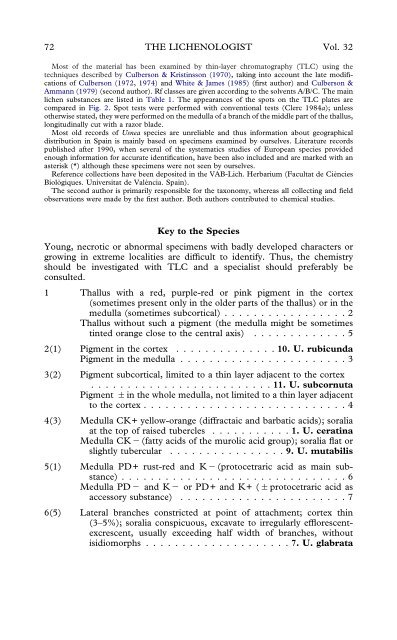the lichen genus usnea on quercus suber in iberian cork-oak forests
the lichen genus usnea on quercus suber in iberian cork-oak forests
the lichen genus usnea on quercus suber in iberian cork-oak forests
You also want an ePaper? Increase the reach of your titles
YUMPU automatically turns print PDFs into web optimized ePapers that Google loves.
72 THE LICHENOLOGIST Vol. 32<br />
Most of <str<strong>on</strong>g>the</str<strong>on</strong>g> material has been exam<strong>in</strong>ed by th<strong>in</strong>-layer chromatography (TLC) us<strong>in</strong>g <str<strong>on</strong>g>the</str<strong>on</strong>g><br />
techniques described by Culbers<strong>on</strong> & Krist<strong>in</strong>ss<strong>on</strong> (1970), tak<strong>in</strong>g <strong>in</strong>to account <str<strong>on</strong>g>the</str<strong>on</strong>g> late modificati<strong>on</strong>s<br />
of Culbers<strong>on</strong> (1972, 1974) and White & James (1985) (first author) and Culbers<strong>on</strong> &<br />
Ammann (1979) (sec<strong>on</strong>d author). Rf classes are given accord<strong>in</strong>g to <str<strong>on</strong>g>the</str<strong>on</strong>g> solvents A/B/C. The ma<strong>in</strong><br />
<str<strong>on</strong>g>lichen</str<strong>on</strong>g> substances are listed <strong>in</strong> Table 1. The appearances of <str<strong>on</strong>g>the</str<strong>on</strong>g> spots <strong>on</strong> <str<strong>on</strong>g>the</str<strong>on</strong>g> TLC plates are<br />
compared <strong>in</strong> Fig. 2. Spot tests were performed with c<strong>on</strong>venti<strong>on</strong>al tests (Clerc 1984a); unless<br />
o<str<strong>on</strong>g>the</str<strong>on</strong>g>rwise stated, <str<strong>on</strong>g>the</str<strong>on</strong>g>y were performed <strong>on</strong> <str<strong>on</strong>g>the</str<strong>on</strong>g> medulla of a branch of <str<strong>on</strong>g>the</str<strong>on</strong>g> middle part of <str<strong>on</strong>g>the</str<strong>on</strong>g> thallus,<br />
l<strong>on</strong>gitud<strong>in</strong>ally cut with a razor blade.<br />
Most old records of Usnea species are unreliable and thus <strong>in</strong>formati<strong>on</strong> about geographical<br />
distributi<strong>on</strong> <strong>in</strong> Spa<strong>in</strong> is ma<strong>in</strong>ly based <strong>on</strong> specimens exam<strong>in</strong>ed by ourselves. Literature records<br />
published after 1990, when several of <str<strong>on</strong>g>the</str<strong>on</strong>g> systematics studies of European species provided<br />
enough <strong>in</strong>formati<strong>on</strong> for accurate identificati<strong>on</strong>, have been also <strong>in</strong>cluded and are marked with an<br />
asterisk (*) although <str<strong>on</strong>g>the</str<strong>on</strong>g>se specimens were not seen by ourselves.<br />
Reference collecti<strong>on</strong>s have been deposited <strong>in</strong> <str<strong>on</strong>g>the</str<strong>on</strong>g> VAB-Lich. Herbarium (Facultat de Ciències<br />
Biològiques. Universitat de València. Spa<strong>in</strong>).<br />
The sec<strong>on</strong>d author is primarily resp<strong>on</strong>sible for <str<strong>on</strong>g>the</str<strong>on</strong>g> tax<strong>on</strong>omy, whereas all collect<strong>in</strong>g and field<br />
observati<strong>on</strong>s were made by <str<strong>on</strong>g>the</str<strong>on</strong>g> first author. Both authors c<strong>on</strong>tributed to chemical studies.<br />
Key to <str<strong>on</strong>g>the</str<strong>on</strong>g> Species<br />
Young, necrotic or abnormal specimens with badly developed characters or<br />
grow<strong>in</strong>g <strong>in</strong> extreme localities are difficult to identify. Thus, <str<strong>on</strong>g>the</str<strong>on</strong>g> chemistry<br />
should be <strong>in</strong>vestigated with TLC and a specialist should preferably be<br />
c<strong>on</strong>sulted.<br />
1 Thallus with a red, purple-red or p<strong>in</strong>k pigment <strong>in</strong> <str<strong>on</strong>g>the</str<strong>on</strong>g> cortex<br />
(sometimes present <strong>on</strong>ly <strong>in</strong> <str<strong>on</strong>g>the</str<strong>on</strong>g> older parts of <str<strong>on</strong>g>the</str<strong>on</strong>g> thallus) or <strong>in</strong> <str<strong>on</strong>g>the</str<strong>on</strong>g><br />
medulla (sometimes subcortical) . . . . . . . . . . . . . . . . . 2<br />
Thallus without such a pigment (<str<strong>on</strong>g>the</str<strong>on</strong>g> medulla might be sometimes<br />
t<strong>in</strong>ted orange close to <str<strong>on</strong>g>the</str<strong>on</strong>g> central axis) . . . . . . . . . . . . . 5<br />
2(1) Pigment <strong>in</strong> <str<strong>on</strong>g>the</str<strong>on</strong>g> cortex . . . . . . . . . . . . . . 10. U. rubicunda<br />
3(2)<br />
Pigment <strong>in</strong> <str<strong>on</strong>g>the</str<strong>on</strong>g> medulla . . . . . . . . . . . . . . . . . . . . . . . 3<br />
Pigment subcortical, limited to a th<strong>in</strong> layer adjacent to <str<strong>on</strong>g>the</str<strong>on</strong>g> cortex<br />
. . . . . . . . . . . . . . . . . . . . . . . . . 11. U. subcornuta<br />
Pigment <strong>in</strong> <str<strong>on</strong>g>the</str<strong>on</strong>g> whole medulla, not limited to a th<strong>in</strong> layer adjacent<br />
to <str<strong>on</strong>g>the</str<strong>on</strong>g> cortex . . . . . . . . . . . . . . . . . . . . . . . . . . . . 4<br />
4(3) Medulla CK+ yellow-orange (diffractaic and barbatic acids); soralia<br />
at <str<strong>on</strong>g>the</str<strong>on</strong>g> top of raised tubercles . . . . . . . . . . . 1. U. cerat<strong>in</strong>a<br />
Medulla CK(fatty acids of <str<strong>on</strong>g>the</str<strong>on</strong>g> murolic acid group); soralia flat or<br />
slightly tubercular . . . . . . . . . . . . . . . . 9. U. mutabilis<br />
5(1) Medulla PD+ rust-red and K(protocetraric acid as ma<strong>in</strong> substance)<br />
. . . . . . . . . . . . . . . . . . . . . . . . . . . . . . . 6<br />
Medulla PD and K or PD+ and K+ (protocetraric acid as<br />
accessory substance) . . . . . . . . . . . . . . . . . . . . . . . 7<br />
6(5) Lateral branches c<strong>on</strong>stricted at po<strong>in</strong>t of attachment; cortex th<strong>in</strong><br />
(3–5%); soralia c<strong>on</strong>spicuous, excavate to irregularly efflorescentexcrescent,<br />
usually exceed<strong>in</strong>g half width of branches, without<br />
isidiomorphs . . . . . . . . . . . . . . . . . . . . 7. U. glabrata

















